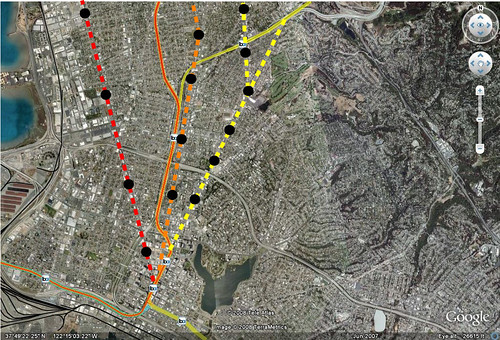In regards to Google, the thinking for the Diridon area is ambitious and much more intelligent than what Apple has done with their suburban campus. By buying up properties around Diridon, they are putting themselves at the center of a major regional transportation hub with light rail, Caltain, High Speed Rail, a revamped bus network, and future BART extensions that allow them to perhaps in the future spend less on their own private transportation modes.
"Google ultimately intends to buy all the parcels in a roughly 240-acre area that would be needed for the mega-campus, said a person familiar with the matter."
Our good friend and podcast guest host Eric Eidlin is also now in San Jose working on the Diridon project so I want to go back in time and pull out a few quotes from Episode 2 of our French HSR podcast as we think about transforming the area around Diridon Station.
Pull Quotes from Episode 2
Stephan De Fay on Return on Investment
"For its part, the French state, in designating a project to be a [project of national importance], is not saying that it wants to receive a full return on its investment in a narrow financial sense. Rather, it is affirming that it wants its money to produce real effects – real effects on the economy, on the housing market—and that these effects are not likely to materialize simply by allowing development to occur in a laissez-faire, Malthusian way."Stephan De Fay on Overcoming Political Boundaries
"The issue that surfaced early on with the Grand Paris project was the strong and enduring divide between the governance structures of the City of Paris and that of the surrounding metropolitan region. Just one figure that is quite awful. In the Paris urban region, we have 1,483 mayors. This is awful in terms of governance. The first step of the Grand Paris was to deal with this. We realized that it was a matter of economic competitiveness. In order Paris to be economically competitive with other global cities—and with London in particular—we realized early one that we needed to overcome this governance problem."Stephan De Fay on Big Development and Transportation Project Timelines
"And one point that bubbled to the top that focused a lot of attention because it’s a very big investment --32 billion Euros in this case—was the transportation project. But the transportation project was actually not really the primary driver. It was a consequence of a vision, where of course, mobility was a crucial element. After articulating the vision, the next step was to figure out how to implement it. And here we came back to transportation. Because the problem between transportation and district redevelopment is that the transportation project takes longer than the first steps of the urban redevelopment of the district. And in fact, you can’t really start the redevelopment of the district in earnest until the transportation infrastructure that will serve it is about to be operational. It is not enough for this infrastructure to simply be promised. And this is the reason why the primary focus of the Grand Paris project today is on the transit stations and supporting infrastructure. Because the stations are the nodes of the urban development of the different districts that surround them."Stephan De Fay on Governance
"One of the clear challenges that I noticed in California – and this hadn’t occurred to me before coming to California in October – relates to governance. In France, we have one French railroad company and not 15. When you enter a transit station in the Bay Area, it is very strange. In San Francisco, for example, when you enter a station it is so strange from a European perspective, that there is a lack of comprehensive passenger information. And there is no integrated ticketing. And so on. But this is a big challenge for the customer. And it is something that needs to be dealt with both at the station level and the district level."Etienne Tricaud on Risk and Integration
"I would also like to mention a risk. Coming from our experience, there is one risk in a project like Diridon or LA Union station. And it is that some decisions are taken too early in terms of infrastructure, in terms of the types of projects and location of projects around the station that become obstacles for the next steps. I remember when we were at Diridon, we had discussions, and I understood that some decisions – or perhaps not decisions, but studies – had been made regarding the location of the future BART portal, as well as for a potential viaduct for the high-speed train. And it is good that studies had been done and reflections made on all of these questions. But decisions on these things should only be made if – and only if – they are considered at a more global scale. And to be sure that the decision is really the right answer for a specific item or issue within the global vision"








